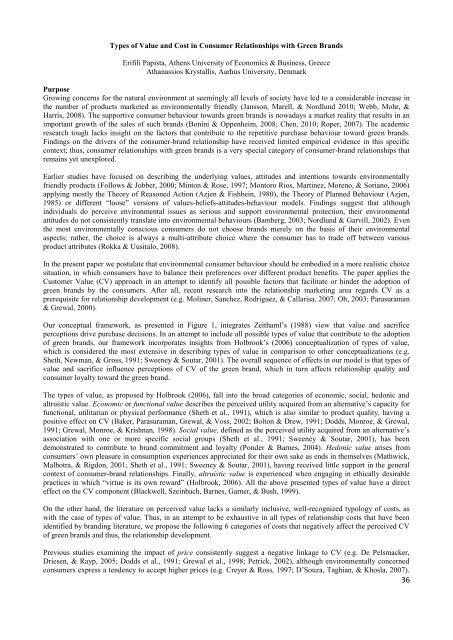Brand, Identity and Reputation: Exploring, Creating New Realities ...
Brand, Identity and Reputation: Exploring, Creating New Realities ...
Brand, Identity and Reputation: Exploring, Creating New Realities ...
You also want an ePaper? Increase the reach of your titles
YUMPU automatically turns print PDFs into web optimized ePapers that Google loves.
Types of Value <strong>and</strong> Cost in Consumer Relationships with Green <strong>Br<strong>and</strong></strong>s<br />
Erifili Papista, Athens University of Economics & Business, Greece<br />
Athanassios Krystallis, Aarhus University, Denmark<br />
Purpose<br />
Growing concerns for the natural environment at seemingly all levels of society have led to a considerable increase in<br />
the number of products marketed as environmentally friendly (Jansson, Marell, & Nordlund 2010; Webb, Mohr, &<br />
Harris, 2008). The supportive consumer behaviour towards green br<strong>and</strong>s is nowadays a market reality that results in an<br />
important growth of the sales of such br<strong>and</strong>s (Bonini & Oppenheim, 2008; Chen, 2010; Roper, 2007). The academic<br />
research tough lacks insight on the factors that contribute to the repetitive purchase behaviour toward green br<strong>and</strong>s.<br />
Findings on the drivers of the consumer-br<strong>and</strong> relationship have received limited empirical evidence in this specific<br />
context; thus, consumer relationships with green br<strong>and</strong>s is a very special category of consumer-br<strong>and</strong> relationships that<br />
remains yet unexplored.<br />
Earlier studies have focused on describing the underlying values, attitudes <strong>and</strong> intentions towards environmentally<br />
friendly products (Follows & Jobber, 2000; Minton & Rose, 1997; Montoro Rios, Martinez, Moreno, & Soriano, 2006)<br />
applying mostly the Theory of Reasoned Action (Azjen & Fishbein, 1980), the Theory of Planned Behaviour (Azjen,<br />
1985) or different ―loose‖ versions of values-beliefs-attitudes-behaviour models. Findings suggest that although<br />
individuals do perceive environmental issues as serious <strong>and</strong> support environmental protection, their environmental<br />
attitudes do not consistently translate into environmental behaviours (Bamberg, 2003; Nordlund & Garvill, 2002). Even<br />
the most environmentally conscious consumers do not choose br<strong>and</strong>s merely on the basis of their environmental<br />
aspects; rather, the choice is always a multi-attribute choice where the consumer has to trade off between various<br />
product attributes (Rokka & Uusitalo, 2008).<br />
In the present paper we postulate that environmental consumer behaviour should be embodied in a more realistic choice<br />
situation, in which consumers have to balance their preferences over different product benefits. The paper applies the<br />
Customer Value (CV) approach in an attempt to identify all possible factors that facilitate or hinder the adoption of<br />
green br<strong>and</strong>s by the consumers. After all, recent research into the relationship marketing area regards CV as a<br />
prerequisite for relationship development (e.g. Moliner, Sanchez, Rodriguez, & Callarisa, 2007; Oh, 2003; Parasuraman<br />
& Grewal, 2000).<br />
Our conceptual framework, as presented in Figure 1, integrates Zeithaml‘s (1988) view that value <strong>and</strong> sacrifice<br />
perceptions drive purchase decisions. In an attempt to include all possible types of value that contribute to the adoption<br />
of green br<strong>and</strong>s, our framework incorporates insights from Holbrook‘s (2006) conceptualization of types of value,<br />
which is considered the most extensive in describing types of value in comparison to other conceptualizations (e.g.<br />
Sheth, <strong>New</strong>man, & Gross, 1991; Sweeney & Soutar, 2001). The overall sequence of effects in our model is that types of<br />
value <strong>and</strong> sacrifice influence perceptions of CV of the green br<strong>and</strong>, which in turn affects relationship quality <strong>and</strong><br />
consumer loyalty toward the green br<strong>and</strong>.<br />
The types of value, as proposed by Holbrook (2006), fall into the broad categories of economic, social, hedonic <strong>and</strong><br />
altruistic value. Economic or functional value describes the perceived utility acquired from an alternative‘s capacity for<br />
functional, utilitarian or physical performance (Sheth et al., 1991), which is also similar to product quality, having a<br />
positive effect on CV (Baker, Parasuraman, Grewal, & Voss, 2002; Bolton & Drew, 1991; Dodds, Monroe, & Grewal,<br />
1991; Grewal, Monroe, & Krishnan, 1998). Social value, defined as the perceived utility acquired from an alternative‘s<br />
association with one or more specific social groups (Sheth et al., 1991; Sweeney & Soutar, 2001), has been<br />
demonstrated to contribute to br<strong>and</strong> commitment <strong>and</strong> loyalty (Ponder & Barnes, 2004). Hedonic value arises from<br />
consumers‘ own pleasure in consumption experiences appreciated for their own sake as ends in themselves (Mathwick,<br />
Malhotra, & Rigdon, 2001; Sheth et al., 1991; Sweeney & Soutar, 2001), having received little support in the general<br />
context of consumer-br<strong>and</strong> relationships. Finally, altruistic value is experienced when engaging in ethically desirable<br />
practices in which ―virtue is its own reward‖ (Holbrook, 2006). All the above presented types of value have a direct<br />
effect on the CV component (Blackwell, Szeinbach, Barnes, Garner, & Bush, 1999).<br />
On the other h<strong>and</strong>, the literature on perceived value lacks a similarly inclusive, well-recognized typology of costs, as<br />
with the case of types of value. Thus, in an attempt to be exhaustive in all types of relationship costs that have been<br />
identified by br<strong>and</strong>ing literature, we propose the following 6 categories of costs that negatively affect the perceived CV<br />
of green br<strong>and</strong>s <strong>and</strong> thus, the relationship development.<br />
Previous studies examining the impact of price consistently suggest a negative linkage to CV (e.g. De Pelsmacker,<br />
Driesen, & Rayp, 2005; Dodds et al., 1991; Grewal et al., 1998; Petrick, 2002), although environmentally concerned<br />
consumers express a tendency to accept higher prices (e.g. Creyer & Ross, 1997; D‘Souza, Taghian, & Khosla, 2007).<br />
36
















